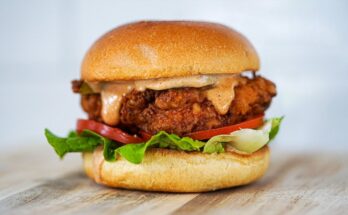Classic Martini Recipe: There’s just something timeless and classy about a martini. Whether it’s the glass, the garnish, or the smooth taste, it’s no wonder the martini has earned a reputation as the king of cocktails. It’s simple, elegant, and incredibly refined when done right. If you’ve ever watched a James Bond movie and wondered what all the fuss was about, you’re not alone. But here’s the secret—while a martini might look fancy, it’s surprisingly easy to make once you understand the basics.
A Brief History of the Martini
The origins of the martini are a bit fuzzy, like many classic cocktails. Some believe it evolved from the Martinez, a gin and vermouth drink popular in the 1800s. Others think it was named after the town of Martinez in California. Either way, the martini as we know it—clean, strong, and sophisticated—really came into its own in the 20th century, especially during the Prohibition era in the U.S. With its smooth taste and high alcohol content, it quickly became a favorite among cocktail enthusiasts and cultural icons alike.
What Makes a Martini “Classic”?
The “classic” martini is made with just two main ingredients: gin and dry vermouth. That’s it. No syrups, no fancy infusions, no elaborate garnishes (unless you count the olive or lemon twist). It’s all about balance. The gin provides the robust base, while the vermouth adds a slightly herbal complexity. The result is a crisp, aromatic drink that’s perfect before dinner—or anytime you want to feel a bit swanky.
Ingredients You’ll Need
Gin vs. Vodka – Your Base Spirit
Let’s clear this up—yes, you can use vodka, but if you want a true classic martini, go with gin. Gin brings depth with its botanical notes (like juniper, citrus, and spices), which play beautifully with vermouth. Vodka, on the other hand, is more neutral. If you prefer a cleaner taste, go vodka. If you want complexity, stick with gin.
Here are some popular choices:
- Gin: Tanqueray, Bombay Sapphire, Beefeater
- Vodka: Grey Goose, Belvedere, Tito’s
Dry Vermouth – The Supporting Star
Don’t skimp on vermouth—it’s the soul of the martini. Dry vermouth is slightly bitter and herbaceous, and it balances out the gin’s punch. A good rule of thumb? Keep it refrigerated after opening to preserve the flavor. Popular dry vermouths include:
- Noilly Prat
- Dolin Dry
- Martini & Rossi Dry
Garnishes – Olive or Twist?
Now comes the personality. The garnish you choose gives your martini its final touch:
- Olive: Savory, salty, and traditional. Use one or three—never two (it’s just a superstition).
- Lemon twist: Adds a pop of citrus and elegance.
- Cocktail onion: That’s a Gibson, not a martini—but we won’t judge.
Tools Required for the Perfect Martini
Shaker or Mixing Glass?
Here’s the deal: Classic martinis are stirred, not shaken. Shaking can “bruise” the gin and create tiny air bubbles that cloud the drink. If you don’t care about tradition, shake away. But if you want that silky-smooth texture, use a mixing glass and a bar spoon.
Jigger – Measure Like a Pro
A jigger is essential for precision. A classic martini usually has:
- 2.5 oz gin
- 0.5 oz dry vermouth
These ratios can vary based on taste, but it’s always better to measure than to eyeball.
Martini Glass – Presentation Matters
Let’s not forget the iconic V-shaped martini glass. Chill it before use (pop it in the freezer or fill with ice water). A cold glass keeps your martini crisp longer and adds a professional touch.
Step-by-Step Instructions
Step 1 – Chill Your Glass
First things first—cold is king. Put your martini glass in the freezer or fill it with ice water while you mix the drink. This keeps your cocktail from warming up too quickly and ensures every sip is refreshing.
Step 2 – Measure and Mix
In a mixing glass:
- Pour 2.5 oz of gin
- Add 0.5 oz of dry vermouth
Use a jigger for accuracy. Add a handful of ice and prepare to stir.
Step 3 – Stir or Shake?
Now the great debate. James Bond liked his shaken, but most bartenders recommend stirring for a reason: it keeps the drink clear and silky. Stir for about 30 seconds—just enough to chill and dilute slightly.
Step 4 – Strain and Serve
Dump the ice water from your chilled glass. Using a strainer, pour the martini into the glass gently. Garnish with your choice of olive or twist, and there you have it—perfection in a glass.
Tips to Customize Your Martini
Dirty Martini
Looking to spice things up? Enter the dirty martini. This variation adds a splash of olive brine to the mix, giving your cocktail a salty, savory twist. It’s a love-it-or-hate-it drink, but if you’re into bolder flavors, this one’s for you.
Here’s how to make it dirty:
- Add 0.5 oz of olive brine to your mix.
- Stir (or shake) as usual.
- Garnish with a couple of green olives.
The key is not to overdo it. Too much brine can make the drink murky and overly salty. Start small and adjust to your taste.
Dry vs. Wet Martini
You’ve probably heard people say “make it extra dry” at a bar. But what does that mean?
- Dry Martini: Less vermouth. Some go as far as just rinsing the glass with vermouth or skipping it altogether. This results in a stronger, more gin-forward drink.
- Wet Martini: More vermouth. This makes the drink a little softer and more aromatic.
It’s all about personal preference. If you’re new to martinis, start with the classic ratio and experiment from there.
Perfect Martini
Contrary to the name, a “perfect martini” doesn’t mean flawless—it means equal parts dry and sweet vermouth. This results in a more balanced, complex flavor. It’s not as common, but worth trying if you’re feeling adventurous.
Recipe for a Perfect Martini:
- 2 oz gin
- 0.25 oz dry vermouth
- 0.25 oz sweet vermouth
- Stir and serve with a lemon twist or cherry
Common Mistakes to Avoid
Even a simple drink like a martini can go wrong. Here are some common missteps and how to dodge them:
- Using warm ingredients – Gin, vermouth, and glassware should all be cold. A lukewarm martini is a buzzkill.
- Too much vermouth – Unless you’re going for a wet martini, keep it minimal. Overpowering vermouth ruins the balance.
- Not measuring – Guesswork leads to inconsistency. Use a jigger.
- Over-shaking or over-stirring – Both can lead to over-dilution. Aim for about 30 seconds of mixing.
- Using bad vermouth – Vermouth goes bad quickly. Always refrigerate after opening and use within a few weeks.
A martini is all about finesse. Treat your ingredients with care and you’ll taste the difference.
Pairing Suggestions
Best Appetizers with a Martini
A martini’s strong and crisp flavor makes it an ideal aperitif—something to enjoy before a meal. Pair it with:
- Olives or nuts – Classic and easy.
- Oysters – The briny flavor complements the drink.
- Smoked salmon – Elegant and smooth.
- Cheese board – Go light: think goat cheese or brie.
You want foods that complement, not overpower, your drink. Stick to light, savory bites and let the martini shine.
When and Where to Enjoy
Martinis are best served in settings where they can be truly appreciated—quiet dinners, evening lounges, or classy home gatherings. They’re not party drinks; they’re sippers, ideal for conversations and unwinding.
Perfect times for a martini:
- Pre-dinner cocktail hour
- Date nights
- Celebrations
- Wind-down weekends
Martinis aren’t just drinks—they’re moments in a glass.
FAQs about Martini Recipe
Q1: What’s the ratio for a classic martini?
A classic martini typically uses a 5:1 ratio—2.5 oz of gin to 0.5 oz of dry vermouth. However, you can adjust this based on how dry or wet you prefer it.
Q2: Can I use vodka instead of gin?
Absolutely. Vodka martinis are a popular variation and offer a smoother, more neutral taste compared to the botanical notes of gin.
Q3: Why is my martini cloudy?
It was likely shaken instead of stirred. Shaking introduces air bubbles and ice shards, which can cloud the drink. Stirring keeps it clear and smooth.
Q4: How do I make it extra dry?
Use very little or no vermouth. Some even just rinse the glass with vermouth and dump it before adding the gin or vodka.
Q5: What’s the difference between shaken and stirred?
Stirring results in a clearer, silkier texture, while shaking dilutes more and can make the drink slightly frothy and colder. Bond preferred it shaken—but most bartenders will say stirring is the way to go.
Conclusion
The classic martini is a timeless symbol of elegance and simplicity. With just a few ingredients and the right technique, you can create a cocktail that speaks volumes. Whether you’re a gin lover or a vodka fan, a traditionalist or an experimental type, the martini can be customized to fit your palate perfectly. The secret lies in quality ingredients, precise measurements, and just a bit of cocktail confidence.
So grab your shaker—or your mixing glass—and give it a try. With each sip, you’ll understand why the martini remains a legend in the cocktail world. Cheers!



